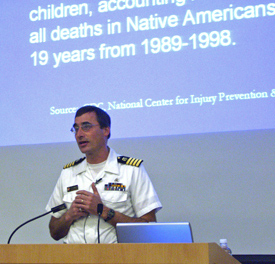Alum Addresses Health Disparities Among Native Americans
 |
Patrick O’Connor, MD, ’82, likened the Indian reservation on which he has worked for more than 20 years to a Third World country in terms of health disparities but one that is being treated medically with first-world resources thanks to the U.S. Public Health Service. His lecture to medical students was part of the health disparities and solutions speaker series for 2007.
More than 70 students gathered in the Daniel Hale Williams Auditorium to hear Dr. O’Connor, a pediatrician, tell of the many challenges and relatively few victories involved in providing medical care on an Indian reservation in Tuba City, Arizona. A captain in the U.S. Public Health Service, which oversees the Indian Health Service, Dr. O’Connor is part of a medical team that provides care for approximately 180,000 Navajo, and some Hopi, people in an area the size of West Virginia.
With a median household income that is one half of U.S. households, 18 percent of the Navajos on the reservation have no vehicle. “That translates into significant health problems,” said Dr. O’Connor. “Some of our people live 50 miles from the nearest health care facility on roads that can be impassable in certain kinds of weather.”
Rates of mental health disorders, speech impairments, learning disabilities, mental retardation, mood and anxiety disorders, suicide, homicide, accidents, and trauma are higher among Native Americans than among the general white, non-Hispanic, population in the U.S., according to a report published by the federal government in 2000. Dr. O’Connor attributes the high suicide rate to the higher incidence of mental health disorders, which are present among poor people everywhere but notes that there is a cultural element too. “Although not condoned, suicide has been a recognized out for hundreds of years,” he said. “If the situation is terrible, it’s considered a thinkable option.”
Obesity rates are rising as in much of the country, but a study conducted by the National Institutes of Health revealed that a 40-year-old Native American has a 60 percent chance of developing diabetes. “Some relate that to a ‘thrifty gene’ among Native Americans,” Dr. O’Connor said. The gene, which causes Native American metabolisms to be very efficient with the use of calories consumed, was useful back in the days of desert farming when food was often scarce, but now it serves as a handicap. “Diabetes is a devastating disease, and many more Native Americans are being wiped out by diabetes and its complications than Kit Carson could have ever hoped to eliminate.”
When asked by a medical student how the natives react to a uniformed federal officer living on their reservation, his response was positive. “The Navajo and the Hopi have a strong tradition of serving in the military,” he said, referring to the Code Talkers of World War II, Navajo Army volunteers who developed a code based on their native language that was never broken by Japanese cryptographers. Respect for the culture has also led to good relations. Dr. O’Connor and his colleagues routinely refer patients to native healers and vice versa. “When parents take their sick child to a medicine man, he will tell them to go to the hospital first to get medicine and then return,” he said. “We in Western medicine know how to cure the chemical imbalances, and the native healers are much better at curing the soul.”
He notes that the amount of money the federal government appropriates for Native American health care is about half of what it spends on health care for federal prisoners, despite the government’s contractual treaty with the native population. That translates into less access to physicians, nurses, and pharmacists, along with aged health care facilities.
Despite the disparities in income, employment, education levels, and access to health care, Dr. O’Connor reports some victories—lower infant mortality rates, attributed to improved prenatal care; and the elimination of Haemophilus influenzae B disease thanks to a vaccine developed in the late 80s—but calls them “technological” successes.
He gives special credit to the six public health nurses who travel the reservation. “They know where virtually every person is despite the huge area, and who’s late on their immunizations,” he said. “We have 700 staff people at our hospital, and those six nurses are probably the most important.”
Quoting from an article published in the December 2006 issue of American Journal of Public Health, Dr. O’Connor notes that health disparities are nothing new to Native Americans. According to the article, the early Europeans thought it was God’s will that the natives should die of smallpox so the land could be opened up for the settlers. “The bottom line is that there is a socioeconomic status that is causing the persistence of health disparities among Native Americans,” said Dr. O’Connor.






